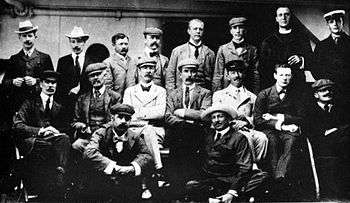Joseph Frederick Laycock
| Sir Joseph Frederick Laycock | |
|---|---|
| Born | 12 June 1867 |
| Died | 10 January 1952 |
| Allegiance |
|
| Service/branch | British Army |
| Rank | Brigadier |
| Commands held |
Nottinghamshire Royal Horse Artillery CRHA ANZAC Mounted Division |
| Battles/wars |
Second Boer War First World War |
| Awards |
Knight Commander of the Order of St Michael and St George Distinguished Service Order Territorial Decoration |
| Relations | Robert Laycock |
Brigadier Sir Joseph Frederick Laycock KCMG DSO TD (12 June 1867 – 10 January 1952) was a British soldier, and Olympic sailor.
Military career
Laycock served with the Nottinghamshire (Sherwood Rangers) Yeomanry in South Africa during the Second Boer War 1899-1900, for which he was appointed a Companion of the Distinguished Service Order (DS) in November 1900.[1]
Back in the United Kingdom, Laycock was the High Sheriff of Nottinghamshire in 1906.[2] He was the first colonel of the Nottinghamshire Royal Horse Artillery when it was formed in 1908 as part of the new Territorial Force. He funded the founding of the battery himself.[3]
During the First World War he served with his battery in the Middle East and also served with the Duke of Westminster's armoured car unit when it was involved in a widely reported incident where it rescued prisoners of war from Senussi tribesmen.[4] Later he became the Commander Royal Artillery for the ANZAC Mounted Division.[5] During the Second World War, he commanded the Nottinghamshire Home Guard.[6]
He was friends with Hugh Grosvenor, 2nd Duke of Westminster,[3] and they competed together in the 1908 Olympics at Water Motorpsort.[6]
He lived at Wiseton Hall in Nottinghamshire.[3] and was a Deputy Lieutenant and Lord Lieutenant for that county.
One of his children, Sir Robert Laycock, was also knighted and awarded the Distinguished Service Order for his services in the Second World War.

Reference and external links
- ↑ The London Gazette: no. 27359. p. 6303. 27 September 1901.
- ↑ The London Gazette: no. 27890. p. 1433. 27 February 1906. Retrieved 13 April 2008.
- 1 2 3 Nottingham Evening Post 20 May 1997
- ↑ The Western Frontier Force
- ↑ Farndale, Martin (1988). The Forgotten Fronts and the Home Base, 1914-18. Henry Ling. p. 440.
- 1 2 Burke, Sir Bernard (1969), Burke's Genealogical and Heraldic History of the Landed Gentry: Volume 2, Burke's Peerage (p. 390)
- ↑ "FinestHour" (pdf). Journal of the Churchill Center and Societies, Summer 2005. Retrieved 2 August 2007.